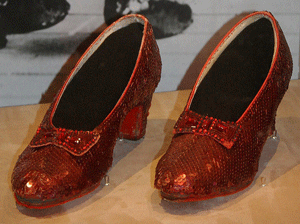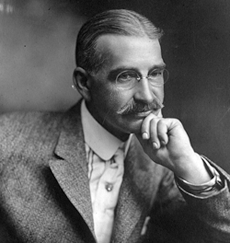|
(Almost) Antique: Dorothy’s Ruby Slippers
Answer
to Name
This Famous Antique Game - March 2014
By Mike McLeod
|
 |
Sherry Blanton, Ted Carlton of Utah, Scott and Carolyn Brown of Memories Flea An'Tique Mall in Prattville, Ala., Teresa P. Bland, Jim Pruett of Eastbrook Flea Market and Antique Mall in Montgomery, Ala., and Sherron Lawson of Roswell, Ga., easily identified Dorothy’s ruby slippers.
While there were more than one pair of ruby slippers made for Judy Garland to wear in The Wizard of Oz, this pair was well-worn and probably used often in the movie. They are 9.5 inches long and are made of plastic, fabric and sequins. In the book, Dorothy’s magical shoes taken from the Wicked Witch of the East were silver. In the movie, they were changed to ruby slippers so they would stand out while she was walking on the Yellow Brick Road.1
|

|
One pair of Dorothy’s ruby slippers
that now reside
in the Smithsonian.
(Photo, courtesy of dbking.)
|
In addition to the Wicked Witches of the East and West, there were also Wicked Witches of the North and South in L. Frank Baum’s books about Oz, along with 100 other characters like Glass Cat, Wise Donkey, Johnny Dough, Great Royal Marshmallow, Jack Pumpkinhead and Fyter the Tin Soldier.
There is an interesting backstory as to how the ruby slippers came into Dorothy’s possession. In the books, the Wicked Witch of the East ruled the eastern quarter of Oz (the other witches ruled their respective quarters), and she forced the Munchins to do her bidding and find food for her. She did other terrible acts, such as enchanting the ax of woodman Nick Chopper, causing it to cut off his limbs one by one. Gruesome, but never fear, Nick had his limbs replaced with tin arms and legs with the help of Ku-klip the tinsmith. Eventually his whole body was tin. Thus, he became the Tin Man or the Tin Woodman (not “Woodsman”). A heart, however, was somehow forgotten.
Because Nick Chopper was in love with Nimee Aimee who lived with the Wicked Witch of the East, the witch decided to turn her into a crone to spoil their romance. While searching for herbs to make a potion, Dorothy Gale’s house fell on the Wicked Witch of the East, ending her plans and her life. Now you know why she was in Munchkin Land at that fateful moment.
L. Frank Baum wrote 14 novels about Oz, initially from stories he told his children before bedtime. His son and great-grandson, Frank Joslin Baum and Roger S. Baum, also wrote stories about Oz, as did many other writers. Frank and Roger respectively wrote The Laughing Dragon of Oz, 1935, and Dorothy of Oz, 1985, parts of which were used in the movie, Oz the Great and Powerful (2013). All told, there are more than 100 books about Oz and many plays, movies and TV shows.
|

|
L. Frank Baum, author of The Wizard of Oz.
|
In 2012, one pair of the five or six pairs of ruby slippers made was sold for $2 million to Leonardo DiCaprio representing a group of investors, including Steven Spielberg. The group donated the slippers to the Academy Museum in Los Angeles. That particular pair was used for the close-up shots of the slippers during the movie.
Judy Garland (Frances Ethel Gumm, June 10, 1922-June 22, 1969) was paid $500 per week for acting in the movie that required five months of filming. She was 16 at the time. Her co-stars made the following amounts each week they worked: Frank Morgan (Professor Marvel, the Doorman, Cabby, Guard, and The Wizard of Oz2), $1,500; Ray Bolger (Hunk and The Scarecrow), $3,000; Jack Haley (Hickory and The Tin Man), $3,000; Bert Lahr (Zeke and The Cowardly Lion), $1,500; Margaret Hamilton (Miss Gulch and The Wicked Witch of the West), $1,000; Billie Burke (Glinda the Good Witch of the North), $766.67; Charley Grapewin (Uncle Henry), $750; Clara Blandick (Auntie Em), $750; and Terry the Dog (Toto), $125.3
Don’t feel too bad for Judy Garland making less per week than all the other main actors except Toto—she worked the most, and $500 in her day is equivalent to $8,000 today.
The Wizard of Oz won two Academy Awards (Best Song and Best Original Score) out of its six nominations, but it was going against stiff competition: Gone With The Wind, Stagecoach, Mr. Smith Goes To Washington, Gulliver’s Travels, Wuthering Heights, Of Mice and Men, The Man in the Iron Mask, and Drums Along the Mohawk. Judy Garland won the Academy Juvenile Award for her performance.
Victor Fleming directed both The Wizard of Oz and Gone With The Wind, and he won the award for Best Director for Margaret Mitchell’s novel. He wasn’t nominated for Oz.
Sadly, L. Frank Baum was not alive to celebrate his creation’s success in the cinema. He died on May 6, 1919.
-----------------------------------
1 Filmsite.org.
2 The Wizard’s full name was Oscar Zoroaster Phadrig Isaac Norman Henkle Emmannuel Ambroise Diggs, as revealed in Lyman Frank Baum’s The Annotated Wizard of Oz: The Wonderful Wizard of Oz, W W Norton and Co. publisher.
3 Webwizard.com.
|